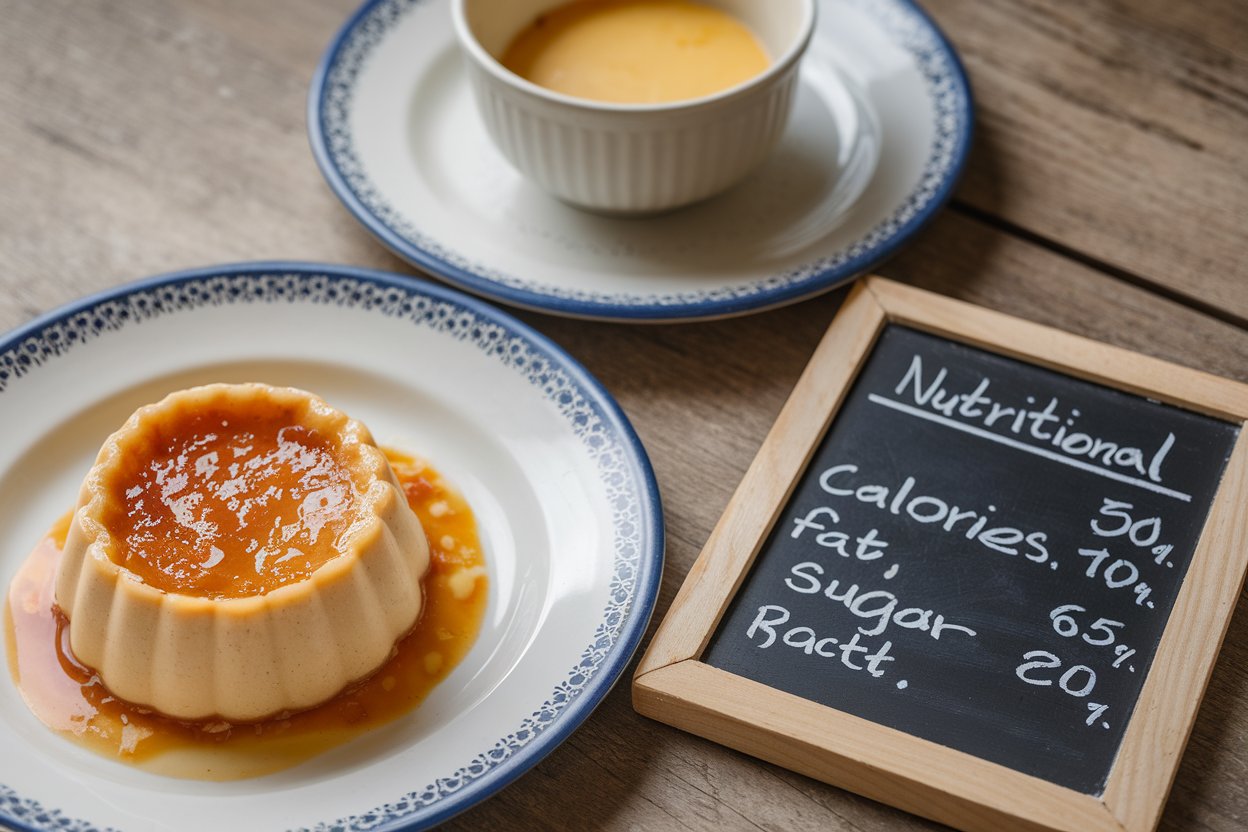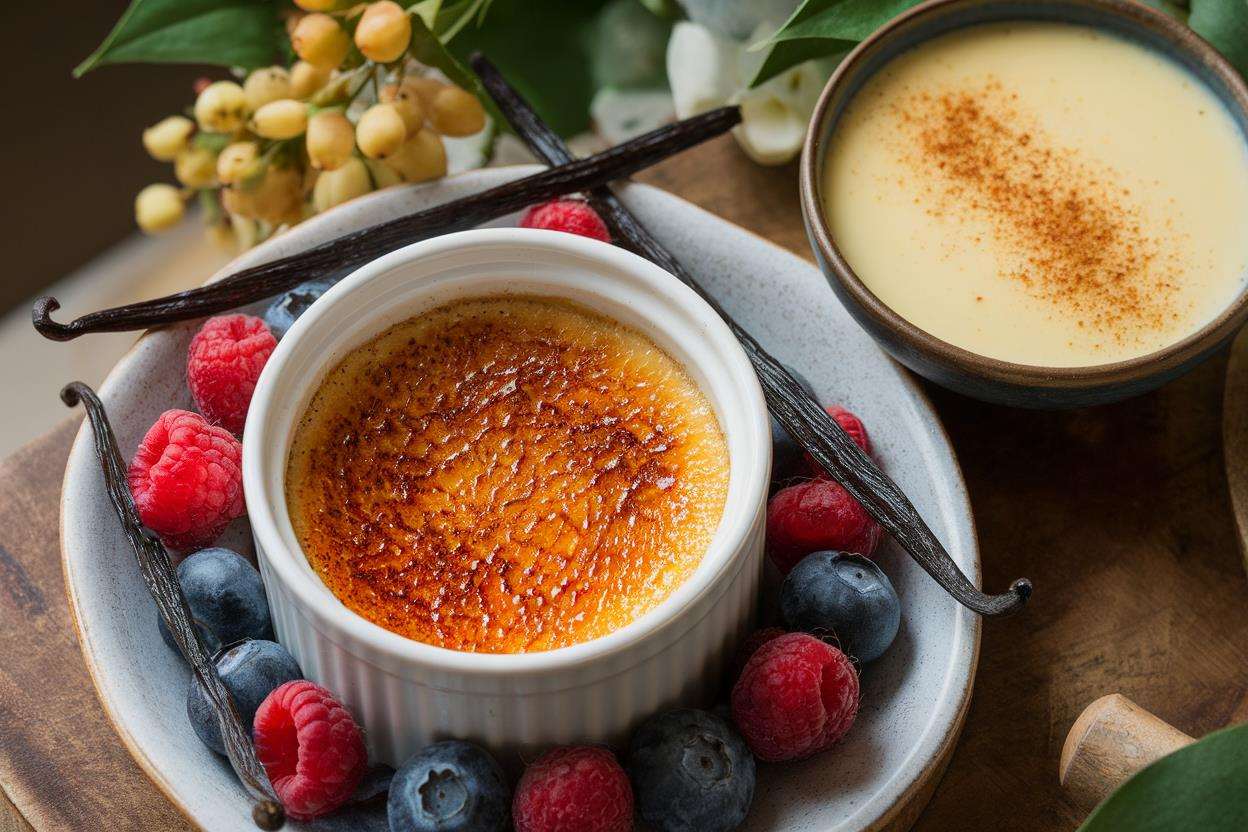When it comes to desserts, crème brûlée and custard are like siblings—they share some similarities but have their own unique personalities. If you’ve ever wondered, “Are they the same thing?” or “What makes them different?” then you’re in the right place! Let’s dive into the delicious world of crème brûlée and custard to uncover what sets these two sweet treats apart. 🍮✨
Crème brûlée and custard are both creamy, dreamy, and oh-so-satisfying desserts that have stood the test of time. They both involve eggs, sugar, and cream, yet their flavors, textures, and preparation methods create two very distinct dessert experiences.
So, what’s the real deal with these desserts? Let’s start by understanding their origins.
Table of Contents
A Brief History of Crème Brûlée
Crème brûlée, also known as “burnt cream,” traces its roots back to France. However, its exact origins are a little hazy, with some claims suggesting it was first created in England or Spain. What sets it apart is its signature caramelized sugar topping that’s torched to perfection. That satisfying crack when you break into it? Pure magic. 💥
The Origins of Custard: A Culinary Classic
Custard, on the other hand, has been around for centuries and is deeply rooted in European cooking. It’s super versatile—you’ll find it as a filling for pastries, a base for ice cream, or even as a standalone dessert. Unlike crème brûlée, custard doesn’t have a crispy sugar layer on top. Instead, it’s all about the smooth and creamy texture.
Defining Crème Brûlée and Custard
Before we get into the nitty-gritty, let’s break down what exactly these desserts are.
What is Crème Brûlée?
Crème brûlée is a baked custard dessert topped with a layer of hardened caramelized sugar. It’s made with heavy cream, egg yolks, sugar, and vanilla. The magic happens when you sprinkle sugar on top and use a torch (or broiler) to caramelize it.
Fun fact: The caramelized topping isn’t just for looks—it also adds a delightful crunch that contrasts beautifully with the silky custard underneath. 🔥
What is Custard?
Custard is essentially a mixture of milk or cream, eggs, and sugar that’s gently cooked until thickened. It’s the foundation for countless desserts, from tarts to trifles. Depending on how you prepare it, custard can be either firm (baked) or soft (stirred).
Pro tip: If you’re making custard at home, low and slow is the way to go. Too much heat can lead to curdling, and nobody wants scrambled eggs in their dessert. 🥚❌
Key Ingredients of Crème Brûlée and Custard
Both desserts share a similar ingredient list, but the ratios and preparation methods make all the difference. Let’s take a closer look.
| Ingredient | Crème Brûlée | Custard |
|---|---|---|
| Heavy cream | ✔️ | ✔️ |
| Milk | Optional | ✔️ |
| Egg yolks | ✔️ (used generously) | ✔️ |
| Sugar | ✔️ (for sweetness) | ✔️ |
| Vanilla or flavoring | ✔️ | ✔️ |
| Caramelized sugar top | ✔️ | ❌ |
The richness of crème brûlée comes from the heavy cream, while custard often uses milk, making it lighter.
Texture and Consistency: The Major Differences
Here’s where things get really interesting. The texture of these desserts is what truly sets them apart.
How Crème Brûlée Achieves Its Creamy and Crunchy Texture
The texture of crème brûlée is all about balance. The custard base is luxuriously creamy, while the caramelized sugar layer adds a crisp, candy-like crunch. It’s like two desserts in one!
Custard: Smooth and Velvety Delight
Custard is all about simplicity and smoothness. Whether baked or stirred, it’s meant to melt in your mouth. The lack of a crunchy topping allows you to fully appreciate its silky texture.
Cooking Methods for Crème Brûlée and Custard
The way you prepare these desserts plays a huge role in their final taste and texture.
How Crème Brûlée is Prepared
Making crème brûlée is an art form. Here’s a quick step-by-step:
- Whisk together egg yolks and sugar.
- Heat the cream and slowly mix it into the yolks to avoid scrambling them.
- Pour the mixture into ramekins and bake in a water bath.
- Chill the custard, then sprinkle sugar on top and torch it until caramelized. 🔥
Pro tip: The water bath prevents the custard from overcooking and keeps it silky smooth.
Custard Cooking Techniques
Custard can be baked or stirred on the stovetop. For baked custard, you’ll use a water bath, similar to crème brûlée. For stirred custard, you’ll gently cook the mixture over low heat while stirring constantly.
Common mistake: Don’t rush the cooking process, or you’ll end up with lumpy custard. Slow and steady wins the race! 🐢
Common Variations and Flavors
Variety is the spice of life, and desserts are no exception! Both crème brûlée and custard come in countless flavors and styles, depending on your preferences or the occasion.
Creative Twists on Crème Brûlée
While the classic vanilla crème brûlée is unbeatable, chefs and home cooks alike love experimenting with fun twists. Here are some delicious variations:
- Chocolate Crème Brûlée: For all the chocoholics out there, adding cocoa to the custard base creates a rich, indulgent version of this dessert. 🍫
- Lavender Crème Brûlée: Infusing the cream with dried lavender gives this dessert a floral aroma and a touch of elegance. 🌸
- Espresso Crème Brûlée: A favorite for coffee lovers, this version adds a caffeine kick to the creamy custard. ☕
Quote: “A great crème brûlée is like a blank canvas—you can add almost any flavor to make it uniquely yours.”
Diverse Types of Custard
Custard’s versatility makes it a staple in many cuisines. Some popular variations include:
- Pastry Cream: Thicker and sweeter, pastry cream is often used as a filling for éclairs, cream puffs, and fruit tarts.
- Flan (or Caramel Custard): A baked custard with a soft caramel topping, flan is a favorite across Latin America and Spain.
- Crème Anglaise: A pourable custard sauce that pairs beautifully with cakes and fruit desserts.
Did you know? In England, custard is affectionately called “crème anglaise” or simply “custard sauce,” and it’s often served with traditional puddings.
Presentation and Serving Styles
Part of what makes these desserts so enticing is how they’re presented. Both crème brûlée and custard can steal the show with their elegant looks.
The Elegant Presentation of Crème Brûlée
Crème brûlée is typically served in shallow, round ramekins to showcase its caramelized sugar topping. Once torched, it’s ready to impress at any dinner party. Add fresh berries or a dollop of whipped cream for an extra touch of sophistication.
Pro tip: Always torch the sugar topping just before serving. That way, it stays crispy and doesn’t melt into the custard.
Serving Suggestions for Custard
Custard is the ultimate multitasker. Serve it warm with a sprinkle of nutmeg for comfort food vibes, or chill it for a refreshing treat. If you’re feeling fancy, pour crème anglaise over a slice of chocolate cake for an instant upgrade.
Emoji Tip: Want to wow your guests? Garnish custard dishes with edible flowers or a dusting of cocoa powder. 🌺🍫
Popular Misconceptions About Crème Brûlée and Custard
Now let’s tackle some common myths about these desserts. If you’ve ever been confused by the terms, you’re not alone!
Are They the Same Dessert? Debunking Myths
One common misconception is that crème brûlée is just “fancy custard.” While it’s true that crème brûlée is technically a type of custard, the caramelized sugar topping makes it a unique dessert in its own right.
Differences That Confuse Many Dessert Lovers
Another mix-up happens with flan and crème brûlée. Both have custard bases, but flan is topped with soft caramel sauce, not the hard sugar crust of crème brûlée. Think of flan as crème brûlée’s gooier cousin. 😉
Health and Nutritional Comparisons
Desserts aren’t just about indulgence—sometimes you want to know what you’re putting into your body. Let’s compare the nutritional profiles of crème brûlée and custard.
Calories and Macronutrient Breakdown
| Nutrient | Crème Brûlée (per serving) | Custard (per serving) |
|---|---|---|
| Calories | 250–300 | 150–200 |
| Total Fat | 20g | 10g |
| Protein | 4g | 5g |
| Carbs | 25g | 18g |
Crème brûlée is richer due to the heavy cream, while custard is lighter and more adaptable to dietary preferences.
Healthier Alternatives and Modifications
If you’re looking to cut back on calories, try these swaps:
- Use coconut milk or almond milk instead of cream for custard.
- Opt for stevia or a sugar substitute to reduce the sweetness.
- For crème brûlée, consider using Greek yogurt in place of heavy cream for a protein-packed twist.
Common Problems and Solutions in Making Crème Brûlée
Making crème brûlée can be intimidating, but with a little patience, you’ll get it right. Here are some common problems and how to fix them.
Overcoming Cracking and Burning Issues
If your custard cracks in the oven, you’ve likely overcooked it. Always bake it at a low temperature in a water bath. And when caramelizing the sugar, keep the torch moving to avoid burning.
Achieving the Perfect Caramelized Top
The trick to a flawless sugar crust is to use fine sugar and spread it evenly. Too much sugar will clump, while too little won’t caramelize properly. Practice makes perfect! 🔥
Common Problems and Solutions in Making Custard
Custard isn’t without its challenges, but a little know-how goes a long way.
Avoiding Curdling and Overcooking
Curdling happens when the eggs cook too quickly. To avoid this, cook custard over low heat and constantly stir. If you see lumps forming, strain the mixture immediately.
Fixing a Runny Custard
If your custard doesn’t set, it’s likely undercooked. Pop it back in the oven (or on the stove) and cook it a little longer until it thickens. Remember, patience is key!
Crème Brûlée and Custard in Popular Culture
These desserts aren’t just delicious—they’ve made their mark in movies, TV shows, and cookbooks.
Iconic Appearances in Movies and TV Shows
Crème brûlée has been featured in countless films, often as a symbol of luxury and sophistication. Meanwhile, custard often represents comfort and nostalgia.
Famous Chefs and Their Signature Recipes
Chefs like Julia Child and Gordon Ramsay have perfected crème brûlée, while custard recipes have been championed by pastry experts like Mary Berry.
Choosing Between Crème Brûlée and Custard
At the end of the day, your choice comes down to personal preference. Are you craving something rich with a crunchy twist? Go for crème brûlée. Prefer something lighter and versatile? Custard is your go-to.
Quote: “Whether you choose crème brûlée or custard, you’re guaranteed a dessert experience that’s both comforting and indulgent.”

Conclusion
Crème brûlée and custard may share some similarities, but their unique flavors, textures, and preparation methods set them apart. Next time you’re in the mood for dessert, why not try both and see which one wins your heart? 💕
Ready to impress your friends with your dessert knowledge? Let me know if you want more recipes, tips, or a deeper dive into the world of sweets! 🍨✨


1 thought on “What’s the Difference Between Crème Brûlée and Custard?”